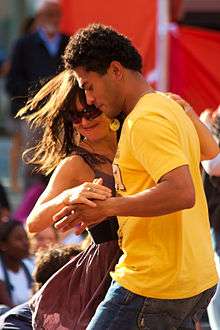Merengue (dance)
Merengue (/məˈrɛŋɡeɪ/,[1] Spanish: [meˈɾeŋɡe]) is a style of Dominican music and dance. Partners hold each other in a closed position. The leader holds the follower's waist with the leader's right hand, while holding the follower's right hand with the leader's left hand at the follower's eye level. Partners bend their knees slightly left and right, thus making the hips move left and right. The hips of the leader and follower move in the same direction throughout the song. Partners may walk sideways or circle each other, in small steps. They can switch to an open position and do separate turns without letting go each other's hands or releasing one hand. During these turns they may twist and tie their handhold into intricate pretzels. Other choreographies are possible.
 | |
| Genre | Caribbean dance |
|---|---|
| Time signature | 4 4 |
| Origin | Dominican Republic |
Although the tempo of the music may be frenetic, the upper body is kept majestic and turns are slow, typically four beats/steps per complete turn.
In the social dancing of the United States the "empalizada" style is replaced by exaggerated Cuban motion, taught in chain ballroom studios for dances of Latin American origin (cha-cha-cha, rumba, mambo, salsa).
History
Merengue Dominican Republic
According to Ramiro Burr, merengue actually comes from acoustic groups.[3] During the 20th century, merengue's original lead instrument was the guitar. By the 1940s and 1950s it was performed with accordions.[4] merengue típico originated in the rural Northern Valley region around the city of Santiago, resulting in the name merengue cibaeño. Merengue típico emphasizes traditional songs dating back as far as the last century. Its performance context and practices differ in their emphasis on a close personal relationship between audiences and performers, which is why the genre of merengue típico is more complex than one familiar of merengue
See also
References
- William R Trumble, Angus Stevenson, ed. (2002). "merengue". Shorter Oxford English Dictionary. 1 (fifth ed.). Oxford: Oxford University Press. pp. 1750. ISBN 0-19-860575-7.
- Blatter, Alfred (2007). Revisiting music theory: a guide to the practice, p.28. ISBN 0-415-97440-2.
- Burr, Ramiro. (2004). Joaquin Diaz: Montreal's Dominican merengue master. p20
- Hutchinson, Sydney. (2006). Merengue Típico in Santiago and New York: Transnational Regionalism in a Neo-Traditional Dominican Music. Ethnomusicology, Vol. 50, No. 1 (Winter, 2006), pp. 37–72. Retrieved from JSTOR
Further reading
- Díaz Díaz, Edgardo. 2008. "Danza antillana, conjuntos militares, nacionalismo musical e identidad dominicana: retomando los pasos perdidos del merengue". Latin American Music Review 29(2): 229–259.